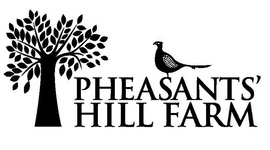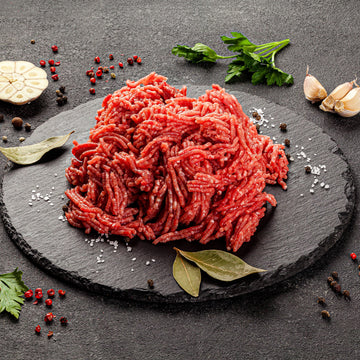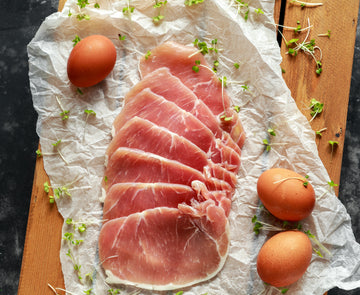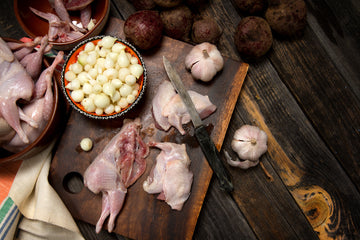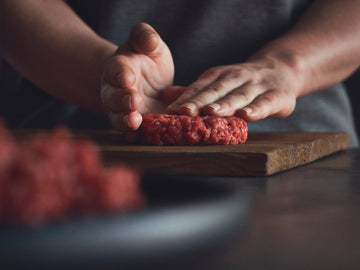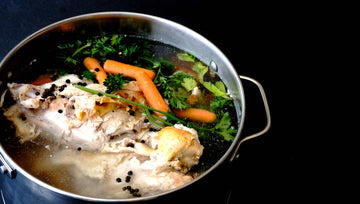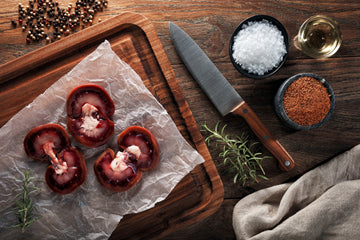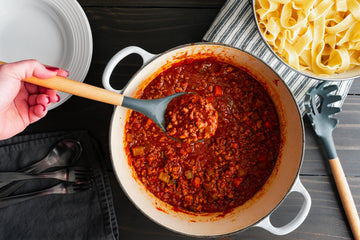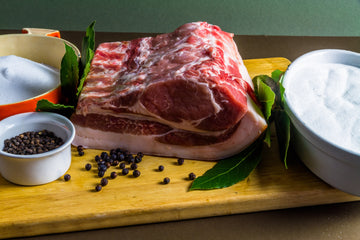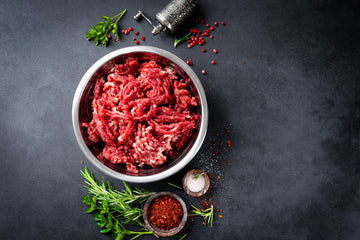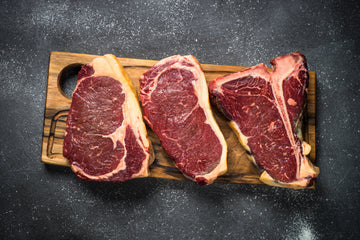How to Cook the Perfect Glazed Christmas Ham: Julia's Step-by-Step Recipe
Dec 23, 2024
Firstly, take note: A boiled ham is a spoiled ham.
Cooking a ham is an all-day affair. It can’t be rushed. It can’t be boiled hastily. A boiled ham is a spoiled ham. Instead, it needs to be lightly poached, where the water never leaves a tremble apart from the occasional bubble. Anything more extreme will make the ham tough. Slow and steady wins the race when it comes to cooking the perfect Christmas ham. It takes time so enjoy the process. Christmas is truly here when the ham is on.
Cooking your ham on Christmas Eve is a game-changer. Try it.
I personally always cook my ham on Christmas Eve while pottering around the house. It's a ceremony for me and one which I really enjoy. The ritual of getting out my biggest pot (which I only use for this recipe), filling it up with water (so heavy I nearly can’t lift it), chopping up the vegetables, picking the bay leaves, and counting the peppercorns (then just chucking more in anyway!) - I love it. When the Christmas Eve ham is on, all is good with the world.
Cook your ham to your taste - try it with Cola like Nigella, or cider for something different - you pick
Apart from the method of poaching the ham slowly, everything else is up for interpretation here. You can cook the ham in cola like Nigella recommends, or I quite like the idea of cooking it in cider like many of our customers do. Some people swear by cooking it in the slow cooker - which is great - as long as you can keep an eye on it and make sure it doesn’t overcook.
As for the ham glaze, choose something sweet that will caramelise
For the glaze, you just need something sweet that will caramelise. I have recommended a combination of honey and brown sugar like Mary Berry does, but Jamie Oliver recommends marmalade which also works very well. I like using dark brown sugar because it gives a lovely colour and treacle taste but again, you do you. It’s your Christmas after all.
Here are my go-to ingredients for the ultimate Christmas ham with a gorgeous glaze
Ingredients
For the ham
1 x 3.2 kg free-range, dry-cured ham
2 carrots
2 celery sticks
1 onion/ green part of a leek or both
2 bay leaves
6-9 whole peppercorns
For the glaze
1.5 tbsp honey
1.5 tbsp brown sugar (I use dark brown sugar)
2 tbsp of mustard (I use Dijon, but you can use English or wholegrain)
To cook your dry-cured ham perfectly, you will need the equipment below
Equipment
- A pot with a lid large enough to fit the ham comfortably.
- A large roasting dish lined with aluminium foil.
- A meat thermometer (not essential but incredibly helpful).
Follow this method for a simple step-by-step guide to cook your glazed Christmas Ham
Method (see the video below)
1. Pop the ham in the pot and cover with cold water until it is completely submerged. Bring the water to the boil and simmer for 5 minutes. There will be a white foam on the water which is simply the excess cure from the ham. We don’t want this in the stock so make sure to drain the ham, throwing away this water. Fill the pot up again with fresh cold water and return to the stove.
2. Add all the chopped vegetables, bay leaves and peppercorns to the water and slowly bring the ham to the boil.
3. As soon as the water is boiling, turn the heat down low. The water should barely be moving, only with small bubbles and a slight tremble. The temperature of the water should be 85 degrees Celsius (this is where a temperature probe comes in very handy).
4. Poach the ham for 25 minutes per 500g, plus 25 minutes at the end. You are looking for a temperature of 75 degrees Celsius in the centre of the ham (meat thermometer coming in handy again). A 3.2kg ham takes 3.5 hours to reach 75 degrees Celsius.
5. Heat your oven to 210 degrees Celsius, and line a baking tray with two layers of foil.
6. Remove the ham from the pot and let it cool slightly (cool enough that you can handle it). The pot is now full of delicious ham stock - strain this to keep for soups and stews. While the ham is cooling, make the glaze by mixing the mustard, sugar and honey in a bowl and set aside.
7. When the ham is mostly cooled, snip off the string and remove. Take a knife and carefully remove the skin and discard, leaving the fat on the ham. Score the ham fat in a crisscross pattern, and place the ham onto a foil lined baking tray.
8. Brush the ham with ½ of the glaze. Pay most attention to the fat, putting most of the glaze on here, with some on the meat too. Place into your preheated oven and check every 2 minutes. It can colour and burn very quickly so keep an eye on it, regularly basting with more glaze.
9. After a couple of bastings, brush the remainder of the glaze over and return to the oven for another 2 minutes. The ham is done when you like the way it looks. Remove from the oven and leave in the tray for 30 minutes.
10. Once the ham is cooled, baste one last time, and put on your favourite platter to serve.
11. It is always easier to carve cold so if you aren’t eating straight away, leave it to cool completely (refrigerated overnight is best) and carve with a very sharp carving knife (not serrated).
A few important notes for preparing your Christmas ham
What weight of ham to buy
I tend to advise people to buy 250g of ham, raw weight, per person. So 4 people would need a 1kg ham, raw weight. But this amount will leave you no leftovers.
If you prefer extra ham for Christmas leftovers...
No leftovers I hear you say?! I know. The Christmas ham, in my opinion, is the greatest of leftovers known to man. So, this is where you use your discretion on how much to buy. I know couples who buy a full ham which could technically feed 14 people. I know people who buy a small ham for Christmas Day and a bigger ham for leftovers. Or, some who just buy enough for the meal and no more. Anyway, there is no judgement here. You do what works for you.
A note on storing your Pheasants' Hill Farm uncooked ham
Your ham must be stored in the fridge, in its vacuum pack, until you cook it. Don’t keep it in your garage, don’t keep it in your car boot. Take everything else out of your fridge that doesn’t absolutely require refrigeration (fruit, vegetables, butter, and alcohol!) and store them somewhere else. Your fridge's job at Christmas time is to keep your meat cold. The end.
A note on soaking your dry-cured ham
You don’t need to pre-soak a Pheasants' Hill Farm free-range ham. We use a special, low-salt cure so soaking isn’t necessary. If anything, it will take away from the flavour. If you aren’t cooking a Pheasants' Hill ham, it will need soaking overnight.
A note about the first boil of your ham
The point of boiling the ham the first time around, and throwing away the first batch of water, is to get rid of any excess cure. Once this step is complete, it means that the liquid it is cooked in next can be used as stock for soups or stews. It is delicious, so don’t waste it.
A note on reheating your Christmas ham
To reheat the ham, I think it’s best to first, slice the ham cold. Next, put in an oven dish with a dash of stock/water, and cover with foil. Reheat very slowly in the oven at a medium-low temperature (150-160 degrees Celsius) until hot. This way it won’t dry out.
Last note: take safety seriously when cooking a Christmas ham
Please always make sure that you are aware of food safety standards before attempting to cook meat. Christmas is a time for good food, but things can easily go wrong if hygiene, storage, cooking temperatures, and reheating guidelines are not adhered to. I'll pop the link to the Food Standards Agency here for your guidance.
Very last note: relish the cherished tradition of preparation, enjoy the simple, step-by-step cooking, breathe in the mouthwatering aroma, and delight in the pure joy that your ham will bring to your table. Wishing you a very Merry Christmas from Julia and the team at Pheasants' Hill Farm.
Comment below to let us know how this recipe worked for you or to share your own traditional Christmas ham tips and recipe ideas.

